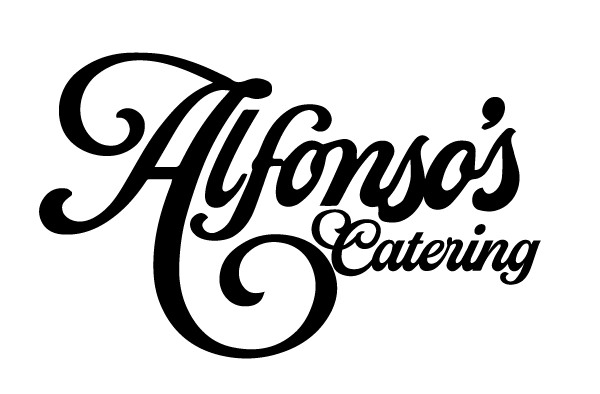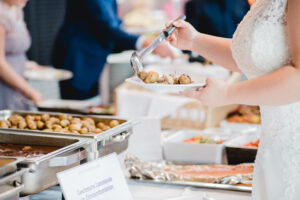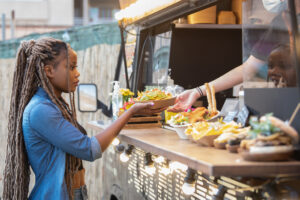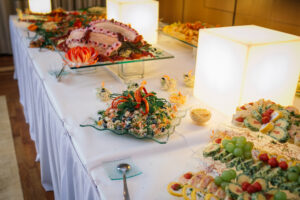The day we catered both a Fortune 500 company’s annual awards gala and a neighborhood block party represented everything I love about what we do. Our team split into two—half creating elegant passed hors d’oeuvres on silver trays amid crystal and candlelight, half serving vibrant street tacos from our converted vintage truck as children played and neighbors caught up.
Same day, same company, worlds apart in presentation—yet in both venues, our food created connections, sparked conversations, and turned ordinary gatherings into memorable experiences.
This duality hasn’t happened by accident. It’s the result of a deliberate philosophy that has shaped our catering business from day one: exceptional food belongs everywhere, from the most exclusive corporate events to casual community celebrations.
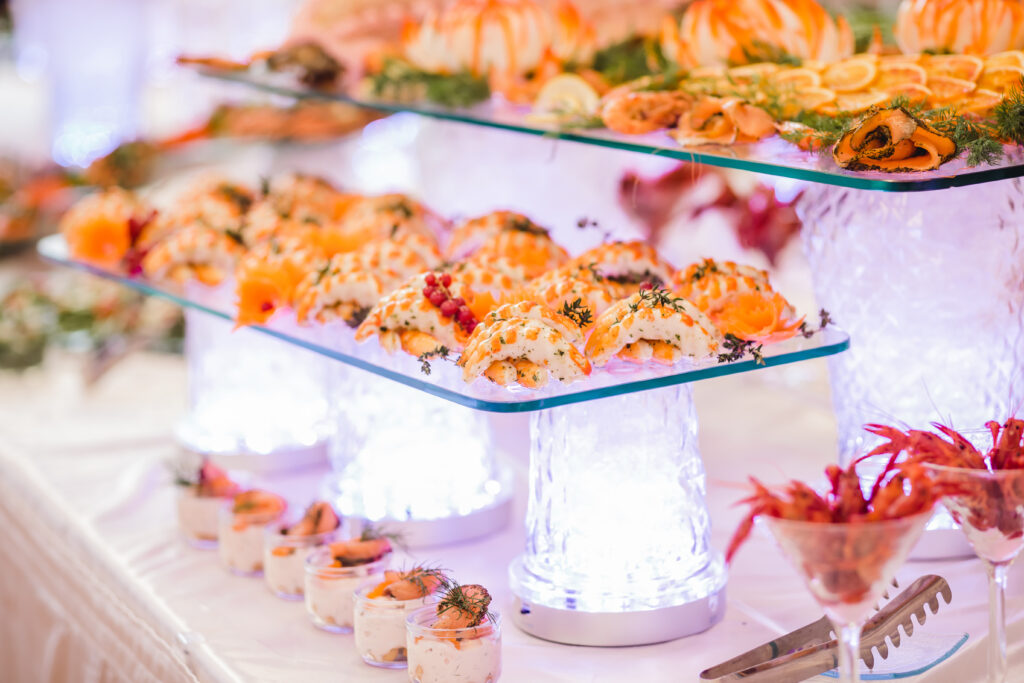
Catering Buffet For Events
How Our Dual Approach Was Born
When I founded this company seven years ago after leaving a high-pressure executive chef position, I had a single vision: to create a catering business that could move seamlessly between formal and casual environments without compromising quality in either. My background included both fine dining restaurants with Michelin aspirations and a deep love for global street food discovered during travels across four continents. The idea of choosing between these worlds seemed unnecessarily limiting.
“Everyone told me to pick a lane,” I often tell new staff during orientation. “Focus exclusively on high-end corporate events or commit to the casual market. Trying to serve both would confuse customers and stretch our operations too thin.”
This conventional wisdom wasn’t wrong about the challenges, but it missed something important: the artificial boundary between “fancy” and “casual” food exists primarily in presentation and setting, not in quality or care. The same impeccably sourced ingredients and culinary techniques could create both a refined plated experience and an unforgettable food truck offering. The key was building systems that could support both worlds without compromise.
Overcoming Operational Challenges
Creating this dual-market approach required solving significant operational puzzles. Corporate events demand precision planning months in advance, while street service thrives on flexibility. Fine dining presentation requires specific equipment and serving pieces that differ entirely from casual service needs. Staff comfortable in black-tie environments don’t necessarily thrive in the high-energy, improvisational setting of a food truck.
“The breakthrough came when we stopped trying to make one team do everything and instead created specialized units under a unified culinary philosophy,” explains our operations director, Elena, who helped architect our current structure. “We share kitchen facilities, purchasing systems, and core culinary staff across divisions, but we’ve built dedicated event teams with the specific skills each market requires.”
This structural solution allowed us to maintain consistent food quality while developing the distinct service styles necessary for different environments. The corporate team mastered the choreography of synchronized service and wine presentation, while the street team honed the art of high-volume execution without sacrificing quality or personal connection.
When Worlds Collide: The Cross-Pollination Effect
The most unexpected benefit of our dual approach has been the creative cross-pollination between seemingly opposite catering worlds. Street food inspirations have brought fresh energy to corporate menus, while the precision techniques from fine dining have elevated our casual offerings.
How Street Food Revolutionized Our Corporate Menus
Three years ago, we introduced our now-signature “elevated street food stations” for corporate receptions—interactive food experiences drawing inspiration from global street food traditions but executed with fine-dining attention to detail. The response was immediate and enthusiastic.
“Our corporate clients were tired of the same passed appetizers and carving stations,” notes our corporate sales director. “The street food concepts brought playfulness and interaction to events that had become formulaic. Suddenly, executives were standing together at our made-to-order Bangkok street noodle station, having genuine conversations while waiting for their custom bowls.”
These concepts worked because they maintained the sophistication corporate clients expected while introducing the communal, interactive elements that make street food culturally significant worldwide. The presentation remained elegant—custom-built food stations with appropriate design elements rather than actual street carts—but the spirit of the food fostered the connections street food naturally creates.
How Fine Dining Elevated Our Casual Service
The influence has flowed equally in the opposite direction. Techniques typically reserved for high-end restaurants have transformed our casual offerings. The 36-hour sous-vide short ribs that garnered praise at corporate events now form the base of our most popular street tacos. The house-fermented hot sauces originally developed for our fine dining clients now line the condiment station at our food truck.
“People don’t expect the level of technique they’re getting when they order from our trucks,” shares our head chef. “We’re not announcing that the carnitas spent twelve hours in precisely controlled ovens before being finished over wood fire, but that attention to detail is why people tell us they’re the best tacos they’ve ever had.”
This commitment to bringing fine-dining quality to casual settings reflects our core belief: everyone deserves exceptional food, regardless of setting or price point.
The Business Impact of Straddling Two Worlds
Beyond the culinary advantages, our dual approach has created significant business benefits. The corporate division provides financial stability with its advance bookings and higher margins, while the street food operation keeps our brand visible and accessible to a broader audience. Perhaps most valuably, each division serves as a marketing channel for the other.
Creating Client Crossover
We’ve seen remarkable crossover between our markets, with corporate clients booking our street food concepts for company picnics and casual celebrations, and street food customers hiring our corporate division for their weddings and significant life events.
“The food truck actually serves as our most effective marketing for corporate catering,” notes our marketing director. “Executives try our food in a casual setting, are blown away by the quality, and suddenly we’re catering their next board meeting or holiday party.”
This organic marketing reduces our customer acquisition costs significantly while creating the most valuable type of business: clients who use our services across multiple contexts and price points.
The Unified Philosophy That Makes It Work
Despite the operational differences between our divisions, a unified philosophy connects everything we do. We believe that food at its best is both art and community—a sensory experience that should delight individually while creating meaningful connections between people.
Whether served on fine china or compostable palm-leaf plates, whether enjoyed in a corporate ballroom or a public park, our food aims to create moments of genuine connection. The techniques and presentations may differ, but the fundamental commitment to quality ingredients, thoughtful preparation, and hospitable service remains constant.
In a world increasingly divided by economic and social boundaries, there’s something quietly revolutionary about refusing to confine exceptional food experiences to exclusive settings. By maintaining our dual approach despite its operational complexities, we’re doing more than building a successful business—we’re making a statement about the democratic potential of culinary excellence and its power to bring people together across traditional boundaries.
